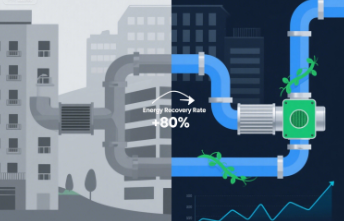As companies strive to meet sustainability and green goals, recovery ventilation systems are making headway as promising technologies to improve indoor air quality with lower energy consumption. Recovery ventilation systems are specifically designed to capture heat from exhaust air and utilize it to precondition incoming fresh air, thus reducing the energy expended to heat and cool the incoming air. This blog will explore the benefits, mechanisms, and emerging trends of recovery ventilation systems in residential and commercial buildings.
Recovery Ventilation System Overview
These systems blend the convenience of supply ventilation with heat recovery systems, thus providing a total fresh air solution for a building. This exchange of energy contributes to overall temperature balance, and energy expenses while reducing the power consumption for heating the spaces. Due to the efficiency of heat exchangers, a substantial portion of energy recovery systems’ energy losses can be recovered making them a vital part of energy-efficient buildings.
Key Benefits of Recovery Ventilation Systems
There are many advantages to implementing recovery ventilation systems. For one, they significantly reduce a company’s expenses, which is critical for any business given the current upwards rise in utility expenses. Recovery ventilation systems also enhance the overall indoor quality of life and health by removing harmful gases and providing adequate fresh air, thereby creating a healthy environment for people to live or work in. Last but not least, recovery ventilation systems are useful in helping to meet stringent building codes and sustainability certifications, which makes them appealing to architects and builders.
Mechanisms of Recovery Ventilation Systems
Various types of heat exchangers, such as plate, rotary and, enthalpy exchangers, form the basis of recovery ventilation systems. Each one of them has their own advantages in relation to the specific needs of a building. For instance, plate heat exchangers are highly efficient and compact, making them very useful in residential applications. Alternatively, rotary heat exchangers are good in climates that require humidity control, as they are capable of transferring both heat and moisture. By understanding the operations of these systems, the right system that matches the energy efficiency needs can be selected, streamlining the systems and processes for all project stakeholders.
Trends and New Ideas in the Industry
The recovery ventilation market is currently advancing rapidly as the need for energy-efficient options grows. There is increased investment in smart automated controls and IoT integration for the real-time monitoring and optimization of ventilation performance. Furthermore, the construction of these systems is incorporating more sustainable materials. With the increased regulatory focus on energy recovery efficiency, we are likely to see increased adoption of recovery ventilation systems in the diverse industry sectors.
The Future of Energy Efficiency
The recovery ventilation systems is a remarkable innovation for the energy efficiency. In addition, these systems are investments for residential and commercial properties because of their ability to enhance indoor air quality and significantly reduce energy use costs. While there are already numerous strategies for improving the recovery ventilation systems, the continued advancement of technology is likely to lead to the development of more innovative and sustainable options. Recovery ventilation systems are not simply a technology to adapt; they are a critical method for achieving a low energy future.

